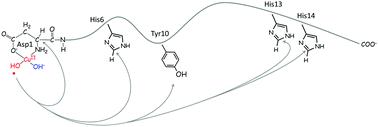当前位置:
X-MOL 学术
›
Metallomics
›
论文详情
Our official English website, www.x-mol.net, welcomes your
feedback! (Note: you will need to create a separate account there.)
On the propagation of the OH radical produced by Cu-amyloid beta peptide model complexes. Insight from molecular modelling
Metallomics ( IF 2.9 ) Pub Date : 2020-09-17 , DOI: 10.1039/d0mt00113a Federica Arrigoni 1 , Fabio Rizza , Renata Tisi , Luca De Gioia , Giuseppe Zampella , Luca Bertini
Metallomics ( IF 2.9 ) Pub Date : 2020-09-17 , DOI: 10.1039/d0mt00113a Federica Arrigoni 1 , Fabio Rizza , Renata Tisi , Luca De Gioia , Giuseppe Zampella , Luca Bertini
Affiliation

|
Oxidative stress and metal dyshomeostasis are considered as crucial factors in the pathogenesis of Alzheimer's disease (AD). Indeed, transition metal ions such as Cu(II) can generate Reactive Oxygen Species (ROS) via O2 Fenton-like reduction, catalyzed by Cu(II) coordinated to the Amyloid beta (Aβ) peptide. Despite intensive effort, the mechanisms of ROS-induced molecular damage remain poorly understood. In the present paper, we investigate on the basis of molecular modelling computations the mechanism of OH radical propagation toward the Aβ peptide, starting from the end-product of OH radical generation by Cu(II)·Aβ. We evaluate (i) the OH oxidative capacity, as well as the energetics of the possible Aβ oxidation target residues, by quantum chemistry Density Functional Theory (DFT) on coordination models of Cu(II)/OH/Aβ and (ii) the motion of the OH˙ approaching the Aβ target residues by classical Molecular Dynamics (MD) on the full peptide Cu(II)/OH/Aβ(1–16). The results show that the oxidative capacity of OH coordinated Cu(II)Aβ is significantly lower than that of the free OH radical and that propagation toward Aβ Asp and His residues is favoured over Tyr residues. These results are discussed on the basis of the recent literature on in vitro Aβ metal-catalyzed oxidation and on the possible implications for the AD oxidative stress mechanism.
中文翻译:

关于 Cu-淀粉样蛋白 β 肽模型复合物产生的 OH 自由基的传播。来自分子建模的见解
氧化应激和金属稳态失调被认为是阿尔茨海默病 (AD) 发病机制中的关键因素。事实上,过渡金属离子如 Cu( II ) 可以通过O 2芬顿样还原产生活性氧 (ROS) ,由与淀粉样蛋白 β (Aβ) 肽配位的 Cu( II )催化。尽管付出了大量努力,但对 ROS 诱导的分子损伤的机制仍知之甚少。在本文中,我们在分子建模计算的基础上研究了 OH 自由基向 Aβ 肽传播的机制,从 Cu( II)产生 OH 自由基的终产物开始)·Aβ。我们通过量子化学密度泛函理论 (DFT) 在 Cu( II )/OH/Aβ 的配位模型上评估 (i) OH 氧化能力以及可能的 Aβ 氧化目标残基的能量学和 (ii) 运动通过经典分子动力学 (MD) 在全肽 Cu( II )/OH/Aβ(1-16)上接近 Aβ 目标残基的OH 的变化。结果表明,OH 配位的 Cu( II )Aβ的氧化能力显着低于自由基的氧化能力,并且向 Aβ Asp 和 His 残基的传播优于 Tyr 残基。这些结果是在最近的体外研究文献的基础上讨论的。 Aβ 金属催化氧化和对 AD 氧化应激机制的可能影响。
更新日期:2020-11-03
中文翻译:

关于 Cu-淀粉样蛋白 β 肽模型复合物产生的 OH 自由基的传播。来自分子建模的见解
氧化应激和金属稳态失调被认为是阿尔茨海默病 (AD) 发病机制中的关键因素。事实上,过渡金属离子如 Cu( II ) 可以通过O 2芬顿样还原产生活性氧 (ROS) ,由与淀粉样蛋白 β (Aβ) 肽配位的 Cu( II )催化。尽管付出了大量努力,但对 ROS 诱导的分子损伤的机制仍知之甚少。在本文中,我们在分子建模计算的基础上研究了 OH 自由基向 Aβ 肽传播的机制,从 Cu( II)产生 OH 自由基的终产物开始)·Aβ。我们通过量子化学密度泛函理论 (DFT) 在 Cu( II )/OH/Aβ 的配位模型上评估 (i) OH 氧化能力以及可能的 Aβ 氧化目标残基的能量学和 (ii) 运动通过经典分子动力学 (MD) 在全肽 Cu( II )/OH/Aβ(1-16)上接近 Aβ 目标残基的OH 的变化。结果表明,OH 配位的 Cu( II )Aβ的氧化能力显着低于自由基的氧化能力,并且向 Aβ Asp 和 His 残基的传播优于 Tyr 残基。这些结果是在最近的体外研究文献的基础上讨论的。 Aβ 金属催化氧化和对 AD 氧化应激机制的可能影响。











































 京公网安备 11010802027423号
京公网安备 11010802027423号